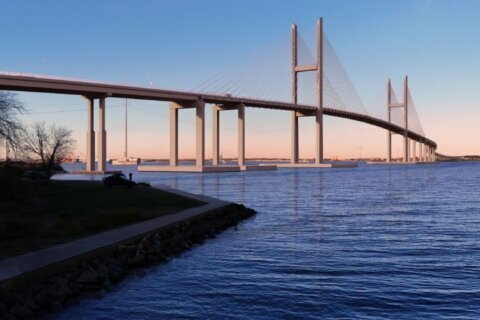WASHINGTON — Soon after Virginia announced its plans to extend Express Lanes almost three miles from Tysons Corner to the American Legion Bridge, Maryland has confirmed a new bridge will be equipped to handle extra traffic.
Without committing to a precise timeline, Maryland’s highway administrator, Greg Slater, said a new American Legion Bridge will be built within the next several years.
“We are focused on the bridge as our first order of business,” Slater told WUSA9. “We want to get out there and move that traffic.”
Virginia Gov. Ralph Northam announced Tuesday new Express Lanes will run in each direction of the Beltway from the Dulles Access Road to the Legion Bridge at the Maryland border. Construction could begin next year.
The announcement left open the question: How would Maryland deal with more traffic on the bridge, that currently carries four lanes over the Potomac River, into Maryland?
In each direction, the bridge has four through-lanes, and one exit lane.
“The only way to address that bridge, and have more capacity on that bridge, is to build a new bridge,” Slater said.
What’s still not clear is the configuration of the bridge, although Slater confirmed to Channel 9 that the new bridge would have additional lanes to allow a seamless flow from Virginia Express Lane traffic into Maryland.
In 2017, Maryland Governor Larry Hogan announced plans for a public-private partnership to add toll lanes to I-270 and the Beltway, but didn’t provide specifics on how the Legion Bridge, which was built in 1963, would carry traffic.
Slater said private developers interested in being part of the project are being directed to develop plans that would add new Beltway lanes within the Interstate’s existing footprint, leaving open the possibilities of stacked roadways or travel underground.
In announcing Virginia’s $1 billion deal with Transurban to build four road projects in Northern Virginia, Transportation Secretary Shannon Valentine said: “It’s also going to provide for Virginians, regardless of what happens in Maryland, direct access to the George Washington Parkway.”
Valentine was asked how, and how quickly the new project would provide relief to those who currently deal with overflow traffic.
“I would like to say immediately,” she said. “Of all the issues, this is one of the top that we hear from citizens about, is the cut-through traffic in McLean.”
Currently, about a quarter million vehicles cross the bridge daily, but over the next 20 years planners estimate that will climb to 300,000 per day.








